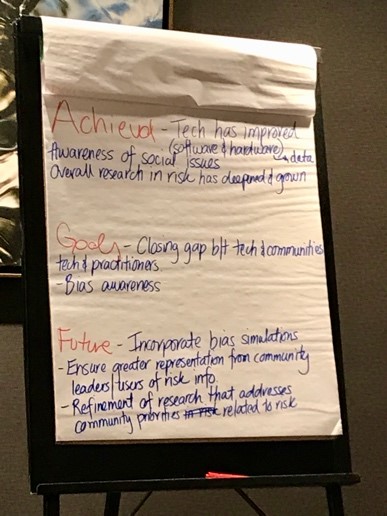By Natasha Udu-gama, Senior Specialist, Thriving Earth Exchange
AGU’s Fall Meeting is a flurry of events for almost everyone. In the midst of this year’s flurry, I had the opportunity to attend the World Bank’s Global Facility for Disaster Reduction and Recovery (GFDRR) Understanding Risk (UR) Forum Planning Meeting for the next Understanding Risk Forum, to be held in Singapore in May 2020.
According to the proceedings from the 2018 UR forum, the community was born in 2010 out of the recognition that disaster risk assessment and identification are activities that cut across sectors and industries. The UR community has met every two years since 2010 and has produced new ideas and partnerships that have improved risk assessments and the communication of risk information. As the initiative approaches its 10th anniversary, organizers encouraged the community to step back and ask: What has the field of risk communication achieved in the last 10 years? What is the role of UR in the next 10 years?
Thriving Earth Exchange was recently introduced to the UR community through a series of meeting with the World Bank’s GFDRR. Given Thriving Earth’s focus on community science—working with communities to understand how their priorities might involve the technical expertise of Earth and space scientists—there seemed to be a natural fit. Therefore, my purpose for attending this planning meeting was to understand better (no pun intended!) the UR community and how Thriving Earth Exchange might play a role now, in the community and, specifically, at the May 2020 forum.
The planning session started with understanding who was in the room. Many of the attendees had not previously attended a UR forum. When we were asked to describe our work by arranging ourselves in different parts of the room like a live scatter graph, the majority seemed to be boundary spanners, much like Thriving Earth Exchange. Following these introductory activities, the organizers asked attendees to address a series of questions via strategically placed flip charts. My group was asked about our impressions of the achievements in the field in the last 10 years, and the goals of the UR forum. Since many of us had not attended UR forums in the past, the best we could do was to surmise and comment based on our own experiences and work in the field. Since my background is in disaster risk reduction and early warning, I was able to draw from my previous experiences and my work at AGU. It was a great opportunity to reflect on how the disaster risk reduction and risk communications fields had evolved during my own evolution from practitioner to researcher to boundary spanner.
Looking around the room, I realized that those present represented organizations and institutions that were builders of risk communication tools and solutions. There were no users of that risk communication. Moreover, there was much discussion of what risk communication tools and solutions had achieved, technically, without a true understanding of what the user experience was on the ground. At one point, one of the organizers asked: Is the UR community ready to move beyond development of risk communications tools and solutions? I was struck by this question. Do we even need to encourage more innovation in risk communication? If innovation was necessary, wouldn’t researchers and practitioners already be motivated to continue innovating? Rather, shouldn’t we be asking communities what, if anything, is actually working? If there are gaps in what has already been developed, then we could encourage researchers and practitioners accordingly.
By the end of the session, we’d had an honest and forthright conversation about what the UR community had achieved, what its goals should be moving forward and how it might consider restructuring to serve the needs of both its community and the people it serves. While Thriving Earth Exchange is only starting to come onto the international scene, many of the lessons we’ve learned domestically can easily translate to international contexts. For example, simply the concept of community science—listening and understanding to communities (‘users’) that need good risk communication, among other needs. If we learn to listen and understand their priorities, we can better develop and hone solutions that address risk communication.
For the 2020 UR forum, Thriving Earth Exchange hopes to hold a project launch workshop comprised of all international community groups and/or train a cohort of interested international scientists on doing community science with the communities where they live, work and play. These types of partnerships will better enhance our own Earth and space science community and allow our sciences to flourish within the communities we cherish.

